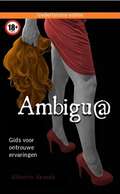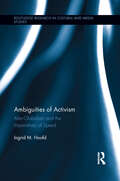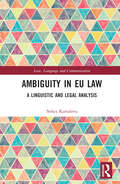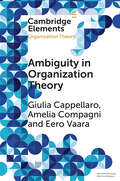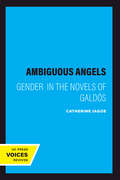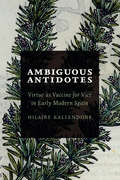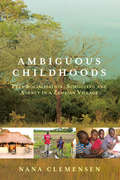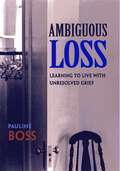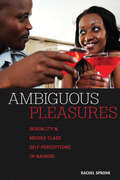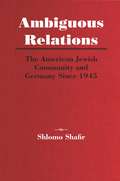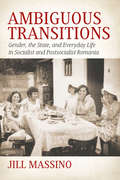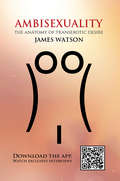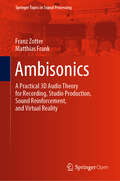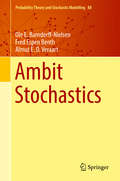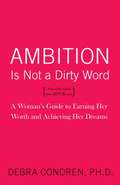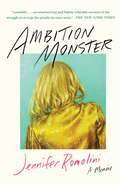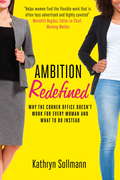- Table View
- List View
Ambigu@: Een gids van ontrouwe ervaringen
by Alberto Aranda de la GalaEen gids van echte ervaringen (over ontrouw) die de auteur altijd in de vorm van een dagboek in de eerste persoon vertelt. Echte situaties, humor, seks, dubbelzinnigheid...en veel zelfhulp bedenkingen.
Ambiguities and Tensions in English Language Teaching: Portraits of EFL Teachers as Legitimate Speakers (ESL & Applied Linguistics Professional Series)
by Peter SayerThe central theme of this book is the ambiguities and tensions teachers face as they attempt to position themselves in ways that legitimize them as language teachers, and as English speakers. Focusing on three EFL teachers and their schools in the southern Mexican state of Oaxaca, it documents how ordinary practices of language educators are shaped by their social context, and examines the roles, identities, and ideologies that teachers create in order to navigate and negotiate their specific context. It is unique in bringing together several current theoretical and methodological developments in TESOL and applied linguistics: the performance of language ideologies and identities, critical TESOL pedagogy and research, and ethnographic methods in research on language learning and teaching. Balancing and blending descriptive reporting of the teachers and their contexts with a theoretical discussion which connects their local concerns and practices to broader issues in TESOL in international contexts, it allows readers to appreciate the subtle complexities that give rise to the “tensions and ambiguities” in EFL teachers’ professional lives.
Ambiguities of Activism: Alter-Globalism and the Imperatives of Speed (Routledge Research in Cultural and Media Studies #43)
by Ingrid M. HoofdThis volume provides a critical and in-depth investigation of the relationship between alter-globalist thinking and practices and their popular discourses. It examines the ways in which several alter-globalist activist groups (like Indymedia, no-borders campaigns, and forms of climate change activism), as well as left-wing intellectuals and academics (like Michael Hardt, Al Gore, Antonio Negri, Hakim Bey, and Geert Lovink), mobilize problematic discourses, tools, and divisions in an attempt to overcome gendered, raced, and classed oppressions worldwide. The book draws out how these mobilizations and theorizations, despite (or possibly because of) their liberatory claims, are actually implicated in the intensification of global hierarchies by repeatedly invoking narratives of transcendence, connection, progress, and in particular of speed. Hoofd argues that the humanist ideals that underlie all these practices paradoxically trigger increasing disenfranchisements worldwide.
Ambiguities of Domination: Politics, Rhetoric, and Symbols in Contemporary Syria
by Lisa WedeenIn Syria, the image of President Hafiz al-Asad is everywhere. In newspapers, on television, and during orchestrated spectacles Asad is praised as the "father," the "gallant knight," even the country's "premier pharmacist. " Yet most Syrians, including those who create the official rhetoric, do not believe its claims. Why would a regime spend scarce resources on a cult whose content is patently spurious? Wedeen concludes that Asad's cult acts as a disciplinary device, generating a politics of public dissimulation in which citizens act as if they revered their leader. By inundating daily life with tired symbolism, the regime exercises a subtle, yet effective form of power. The cult works to enforce obedience, induce complicity, isolate Syrians from one another, and set guidelines for public speech and behavior. Wedeen's ethnographic research demonstrates how Syrians recognize the disciplinary aspects of the cult and seek to undermine them. Provocative and original, Ambiguities of Domination is a significant contribution to comparative politics, political theory, and cultural studies.
Ambiguity and Film Criticism: Reasonable Doubt (Palgrave Close Readings in Film and Television)
by Hoi Lun LawThis book defends an account of ambiguity which illuminates the aesthetic possibilities of film and the nature of film criticism. Ambiguity typically describes the condition of multiple meanings. But we can find multiple meanings in what appears unambiguous to us. So, what makes ambiguity ambiguous? This study argues that a sense of uncertainty is vital to the concept. Ambiguity is what presses us to inquire into our puzzlement over a movie, to persistently ask “why is it as it is?” Notably, this account of the concept is also an account of its criticism. It recognises that a satisfying assessment of what is ambiguous involves both our reason and doubt; that is, reason and doubt can work together in our practice of reading. This book, then, considers ambiguity as a form of reasonable doubt, one that invites us to reflect on our critical efforts, rethinking the operation of film criticism.
Ambiguity and the Absolute: Nietzsche and Merleau-Ponty on the Question of Truth (Perspectives in Continental Philosophy)
by Frank ChouraquiFriedrich Nietzsche and Maurice Merleau-Ponty, Chouraqui argues, are linked by how they conceive the question of truth. Although both thinkers criticize the traditional concept of truth as objectivity, they both find that rejecting it does not solve the problem. What is it in our natural existence that gave rise to the notion of truth?The answer to that question is threefold. First, Nietzsche and Merleau-Ponty both propose a genealogy of “truth” in which to exist means to make implicit truth claims. Second, both seek to recover the preobjective ground from which truth as an erroneous concept arose. Finally, this attempt at recovery leads both thinkers to ontological considerations regarding how we must conceive of a being whose structure allows for the existence of the belief in truth. In conclusion, Chouraqui suggests that both thinkers’ investigations of the question of truth lead them to conceive of being as the process of self-falsification by which indeterminate being presents itself as determinate.
Ambiguity in EU Law: A Linguistic and Legal Analysis (Law, Language and Communication)
by Sofiya KartalovaAmbiguity – an expression or utterance giving rise to at least two mutually exclusive interpretations – has been traditionally regarded as an ever-present, and therefore trivial, feature of EU law, alongside other forms of linguistic indeterminacy. At the same time, ambiguity has been condemned as a perilous defect in the legal text, since it is commonly assumed that the Court of Justice of the EU (CJEU) would necessarily exploit it to engage in judicial activism. In contrast, more recent theories present ambiguity as a means of promoting greater acceptability and coherence, while trusting the CJEU’s willingness to exert judicial restraint for the benefit of judicial co-operation. This ground-breaking work challenges some of the theoretical assumptions about ambiguity in EU law and puts forward a more accurate and complete theory about the CJEU’s strategic use of ambiguity. Ambiguity is here transformed from an underestimated or misunderstood detail of undetermined significance to a desirable systemic feature of the EU legal order with concrete properties and impact. Ambiguity as the implicit basis of the CJEU’s decision-making is shown to be strategically valuable for the implementation of the authority of EU law at some of the most pivotal moments in the evolution of the EU legal order. This interdisciplinary investigation presents in-depth linguistic and legal analysis of ambiguity found in the text of key provisions of EU Treaties and in the language of some of the CJEU’s leading preliminary rulings in the area of fundamental rights, freedom of movement and EU citizenship. The book suggests a categorisation of examples, basic guidance about the type of case and situation where the phenomenon is likely to emerge as well as an assessment of the advantages and disadvantages of this unusual judicial technique. The book will be a valuable resource for researchers and academics working in the areas of Law and Language, Public International Law, EU Law and Multilingualism.
Ambiguity in Organization Theory: From Intrinsic to Strategic Perspectives (Elements in Organization Theory)
by Eero Vaara Giulia Cappellaro Amelia CompagniThis Element presents and discusses the main trajectories in the evolution of the concept of ambiguity and the most relevant theoretical contributions developed around it. It specifically elaborates on both the intrinsic perspectives on ambiguity as an inherent part of organizational decision-making processes and the more recent strategic perspectives on discursively constructed strategic ambiguity. It helps illuminate the path ahead of organizational scholars and offers new avenues for future research. This is important given the ever more pervasive presence of ambiguity in and around organizations and societies.
Ambiguity, Transparency, and Institutional Strength
by S. Nuri ErbaşA report from the International Monetary Fund.
Ambiguous Angels: Gender in the Novels of Galdós
by Catherine JagoeThe contradictory nature of the work of Benito Pérez Galdós, Spain's greatest modern novelist, is brought to the fore in Catherine Jagoe's innovative and rigorous study. Revising commonly held views of his feminism, she explores the relation of Galdós's novels to the "woman question" in Spain, arguing that after 1892 the muted feminist discourse of his early work largely disappears. While his later novels have been interpreted as celebrations of the emancipated new woman, Jagoe contends that they actually reinforce the conservative, bourgeois model of frugal, virtuous womanhood—the angel of the house.Using primary sources such as periodicals, medical texts, and conduct literature, Jagoe's examination of the evolution of feminism makes Ambiguous Angels valuable to anyone interested in gender, culture, and narrative in nineteenth-century Europe.
Ambiguous Antidotes: Virtue as Vaccine for Vice in Early Modern Spain
by Hilaire KallendorfChastity and lust, charity and greed, humility and pride, are but some of the virtues and vices that have been in tension since Prudentius’ Psychomachia, written in the fifth century. While there has been widespread agreement within a given culture about what exactly constitutes a virtue or a vice, are these categories so consistent after all? In Ambiguous Antidotes, Hilaire Kallendorf explores the receptions of Virtues in the realm of moral philosophy and the artistic production it influenced during the Spanish Gold Age. Using the Derridian notion of pharmakon, a powerful substance that can serve as poison and cure, Kallendorf’s original and pioneering insight into five key Virtues (justice, fortitude, chastity, charity, and prudence) reveals an intriguing but messy relationship. Rather than being seen as unambiguously good antidotes, the Virtues are instead contested spaces where competing sets of values jostled for primacy and hegemony. Employing an arsenal of tools drawn from literary theory and cultural studies Ambiguous Antidotes confirms that you can in fact have too much of a good thing.
Ambiguous Childhoods: Peer Socialisation, Schooling and Agency in a Zambian Village
by Nana ClemensenGrowing up with social and economic upheaval in the peripheries of global neoliberalism, children in rural Zambia are presented with diverging social and moral protocols across homes, classrooms, church halls, and the street. Mostly unmonitored by adults, they explore the ambiguities of adult life in playful interactions with their siblings and kin across gender and age. Drawing on rich linguistic-ethnographic details of such interactions combined with observations of school and household procedures, the author provides a rare insight into the lives, voices, and learning paths of children in a rural African setting.
Ambiguous Loss: Learning To Live With Unresolved Grief
by Pauline BossWhat happens when there is mourning with no closure, when a family member or a friend who may be still alive is lost to us nonetheless? How, for example, does the mother whose soldier son is missing in action, or the family of an Alzheimer’s patient who is suffering from severe dementia, deal with the uncertainty surrounding this kind of loss? <p><p> In this sensitive and lucid account, Pauline Boss explains that, all too often, those confronted with such ambiguous loss fluctuate between hope and hopelessness. Suffered too long, these emotions can deaden feeling and make it impossible for people to move on with their lives. Yet the central message of this book is that they can move on. Drawing on her research and clinical experience, Boss suggests strategies that can cushion the pain and help families come to terms with their grief. Her work features the heartening narratives of those who cope with ambiguous loss and manage to leave their sadness behind, including those who have lost family members to divorce, immigration, adoption, chronic mental illness, and brain injury. With its message of hope, this eloquent book offers guidance and understanding to those struggling to regain their lives.
Ambiguous Loss: Learning to Live with Unresolved Grief
by Pauline BossWhen a loved one dies we mourn our loss. We take comfort in the rituals that mark the passing, and we turn to those around us for support. But what happens when there is no closure, when a family member or a friend who may be still alive is lost to us nonetheless? How, for example, does the mother whose soldier son is missing in action, or the family of an Alzheimer’s patient who is suffering from severe dementia, deal with the uncertainty surrounding this kind of loss?In this sensitive and lucid account, Pauline Boss explains that, all too often, those confronted with such ambiguous loss fluctuate between hope and hopelessness. Suffered too long, these emotions can deaden feeling and make it impossible for people to move on with their lives. Yet the central message of this book is that they can move on. Drawing on her research and clinical experience, Boss suggests strategies that can cushion the pain and help families come to terms with their grief. Her work features the heartening narratives of those who cope with ambiguous loss and manage to leave their sadness behind, including those who have lost family members to divorce, immigration, adoption, chronic mental illness, and brain injury. With its message of hope, this eloquent book offers guidance and understanding to those struggling to regain their lives.
Ambiguous Pleasures
by Rachel SpronkAmong both male and female young urban professionals in Nairobi, sexuality is a key to achieving a 'modern' identity. These young men and women see themselves as the avant garde of a new Africa, while they also express the recurring worry of how to combine an 'African' identity with the new lifestyles with which they are experimenting. By focusing on public debates and their preoccupations with issues of African heritage, gerontocratic power relations and conventional morality on the one hand, and personal sexual relationships, intimacy and self-perceptions on the other, this study works out the complexities of sexuality and culture in the context of modernity in an African society. It moves beyond an investigation of a health or development perspective of sexuality and instead examines desire, pleasure and eroticism, revealing new insights into the methodology and theory of the study of sexuality within the social sciences. Sexuality serves as a prism for analysing how social developments generate new notions of self in postcolonial Kenya and is a crucial component towards understanding the way people recognize and deal with modern changes in their personal lives.
Ambiguous Relations: The American Jewish Community and Germany Since 1945
by Shlomo ShafirThe reemergence of a united Germany as a dominant power in Europe has increased even more it's importance as a major political ally and trade partner of the United States, despite the misgivings of some U.S. citizens. Ambiguous Relations addresses for the first time the complex relationships between American Jews and Germany over the fifty years following the end of World War II, and examines American Jewry's' ambiguous attitude toward Germany that continues despite sociological and generational changes within the community. Shlomo Shafir recounts attempts by American Jews to influence U.S. policy toward Germany after the ware and traces these efforts through President Reagan's infamous visit to Bitburg and beyond. He shows how Jewish demands for justice were hampered not only by America's changing attitude toward West Germany as a postwar European power but also by the distraction of anti-communist hysteria in this country. In evaluating the impact of Jewish pressure on American public opinion and on the West German government, Shafir discusses the rationales and strategies of Jewish communal and religious groups, legislators, and intellectuals, as well as the rise of Holocaust consciousness and the roles of Israel and surviving German Jewish communities. He also describes the efforts of German diplomats to assuage American Jewish hostility and relates how the American Jewish community has been able to influence German soul-searching regarding their historical responsibility and even successfully intervened to bring war criminals to trial. Based on extensive archival research in Germany, Israel, and the Unities States, Ambiguous Relations in the first book to examine this tenuous situation in such depth. It is a comprehensive account of recent history that comes to groups with emotional and political reality.
Ambiguous Transitions: Gender, the State, and Everyday Life in Socialist and Postsocialist Romania
by Jill MassinoFocusing on youth, family, work, and consumption, Ambiguous Transitions analyzes the interplay between gender and citizenship postwar Romania. By juxtaposing official sources with oral histories and socialist policies with everyday practices, Jill Massino illuminates the gendered dimensions of socialist modernization and its complex effects on women’s roles, relationships, and identities. Analyzing women as subjects and agents, the book examines how they negotiated the challenges that arose as Romanian society modernized, even as it clung to traditional ideas about gender. Massino concludes by exploring the ambiguities of postsocialism, highlighting how the legacies of the past have shaped politics and women’s lived experiences since 1989.
Ambiguous Transitions: Gender, the State, and Everyday Life in Socialist and Postsocialist Romania
by Jill MassinoFocusing on youth, family, work, and consumption, Ambiguous Transitions analyzes the interplay between gender and citizenship postwar Romania. By juxtaposing official sources with oral histories and socialist policies with everyday practices, Jill Massino illuminates the gendered dimensions of socialist modernization and its complex effects on women’s roles, relationships, and identities. Analyzing women as subjects and agents, the book examines how they negotiated the challenges that arose as Romanian society modernized, even as it clung to traditional ideas about gender. Massino concludes by exploring the ambiguities of postsocialism, highlighting how the legacies of the past have shaped politics and women’s lived experiences since 1989.
Ambisexuality: The Anatomy of Transerotic Desire
by James WatsonAmbisexuals are men who are erotically attracted to 'women with a penis'. Michael simply smiled and said, "I've never been with a man. For me, a trans woman is a woman with masculine genitals, but she is still a woman. She looks like a woman and she acts like a woman." It's the 21st century. Trans women sex workers go to great lengths to meet these needs. Tens of thousands of men like Michael currently live around the world. You might think this is a modern development made possible by sex-change technology. But meticulous research reveals that this unrecognised sexual orientation has persisted across all major cultures throughout recorded history. In spite of this, almost nothing is known about ambisexuality. What motivates their sexual orientation… and the trans women they are drawn to? This book has fascinating anecdotal stories and hard data which leads to deep insights. It will make you re-evaluate what you think you know about human sexuality in an era of growing acceptance of gender diversity and sexual expression.
Ambisonics: A Practical 3D Audio Theory for Recording, Studio Production, Sound Reinforcement, and Virtual Reality (Springer Topics in Signal Processing #19)
by Franz Zotter Matthias FrankThis open access book provides a concise explanation of the fundamentals and background of the surround sound recording and playback technology Ambisonics. It equips readers with the psychoacoustical, signal processing, acoustical, and mathematical knowledge needed to understand the inner workings of modern processing utilities, special equipment for recording, manipulation, and reproduction in the higher-order Ambisonic format. The book comes with various practical examples based on free software tools and open scientific data for reproducible research.The book’s introductory section offers a perspective on Ambisonics spanning from the origins of coincident recordings in the 1930s to the Ambisonic concepts of the 1970s, as well as classical ways of applying Ambisonics in first-order coincident sound scene recording and reproduction that have been practiced since the 1980s. As, from time to time, the underlying mathematics become quite involved, but should be comprehensive without sacrificing readability, the book includes an extensive mathematical appendix. The book offers readers a deeper understanding of Ambisonic technologies, and will especially benefit scientists, audio-system and audio-recording engineers.In the advanced sections of the book, fundamentals and modern techniques as higher-order Ambisonic decoding, 3D audio effects, and higher-order recording are explained. Those techniques are shown to be suitable to supply audience areas ranging from studio-sized to hundreds of listeners, or headphone-based playback, regardless whether it is live, interactive, or studio-produced 3D audio material.
Ambit Stochastics (Probability Theory and Stochastic Modelling #88)
by Fred Espen Benth Ole E. Barndorff-Nielsen Almut E. VeraartDrawing on advanced probability theory, Ambit Stochastics is used to model stochastic processes which depend on both time and space. This monograph, the first on the subject, provides a reference for this burgeoning field, complete with the applications that have driven its development. Unique to Ambit Stochastics are ambit sets, which allow the delimitation of space-time to a zone of interest, and ambit fields, which are particularly well-adapted to modelling stochastic volatility or intermittency. These attributes lend themselves notably to applications in the statistical theory of turbulence and financial econometrics. In addition to the theory and applications of Ambit Stochastics, the book also contains new theory on the simulation of ambit fields and a comprehensive stochastic integration theory for Volterra processes in a non-semimartingale context. Written by pioneers in the subject, this book will appeal to researchers and graduate students interested in empirical stochastic modelling.
Ambit Stochastics (Probability Theory and Stochastic Modelling #88)
by Fred Espen Benth Almut E. Veraart Ole E. Barndorff-NielsenDrawing on advanced probability theory, Ambit Stochastics is used to model stochastic processes which depend on both time and space. This monograph, the first on the subject, provides a reference for this burgeoning field, complete with the applications that have driven its development. Unique to Ambit Stochastics are ambit sets, which allow the delimitation of space-time to a zone of interest, and ambit fields, which are particularly well-adapted to modelling stochastic volatility or intermittency. These attributes lend themselves notably to applications in the statistical theory of turbulence and financial econometrics. In addition to the theory and applications of Ambit Stochastics, the book also contains new theory on the simulation of ambit fields and a comprehensive stochastic integration theory for Volterra processes in a non-semimartingale context. Written by pioneers in the subject, this book will appeal to researchers and graduate students interested in empirical stochastic modelling.
Ambition Is Not a Dirty Word
by Debra CondrenWouldn’t it be great if you could be audaciously ambitious and happy at the same time? You can, and you will. “I’m here to tell you that all of your priorities—personal and ambitious career goals alike—can fit together harmoniously. I’ll show you how, like thousands of women I’ve worked with over the years, you can make more money, earn the credit and recognition you deserve, have more power, and be as ambitious as you want to be. I’ll show you how you can be ambitious without compromising your ethics and integrity. I’ll show you that you can feel worthy and entitled to all of this without fear that you risk sacrificing your desire to have a full, happy personal life and without being afraid that you’ll be less of a woman. It’s worked for me. It’s worked for countless ambitious women I’ve advised. It will work for you. ” —FromAmbition is Not a Dirty Word: A Woman's Guide to Earning Her Worth and Achieving Her Dreams We women aren’t advancing in our careers the way we should. We’re not making the money we deserve or getting the fulfillment we desire. And this timeit’s not men who are holding us back. This time we’re doing it to ourselves, because ambition—for us—is still a dirty word. Debra Condren has coached thousands of women at every level—from those just starting out to the most powerful female executives in the United States—and each one possesses the same fear: if she goes after her dream, she’ll be seen as selfish, bitchy, a bad wife, or bad mother. But it’s exactly this fear of ambition that has forced women to leave the best part of themselves—their dreams, their great talents—by the roadside, rendering them less able to be the whole people they should be in every area of their lives. Condren has a new message and mission: to remind women that ambition is a virtue, not a vice. Ambition is the best of who we are. The real way to have a great life is to see ambition as a part of your value system to which you must give equal attention, along with the other priorities you hold dear, including your spouse, your children, and your friends. InAmbition is Not a Dirty Word, Dr. Condren offers fresh, powerfultools for reclaiming your dreams. Her eight Ambitious Rules provideconcrete, innovative solutions to the everyday struggles we as women face, like taking credit, deflecting detractors, and handling confrontation, so thatyou can become more powerful and fulfilled at work and more satisfied at home. Youcanredefine your ambition in the face of social sanctions and unapologetically go after your dreams without sacrificing the rest of your life. You owe it to yourself and the world to make the contribution you were born to make. Debra Condren will show you how to do it. From the Trade Paperback edition.
Ambition Monster: A Memoir
by Jennifer Romolini&“Entertaining and highly relatable.&” —The New York Times &“As hilarious as it is heart-wrenching…[A] gift of storytelling, and an act of reclamation.&” —Ashley C. Ford, New York Times bestselling author A deeply personal memoir about workaholism, the addictive nature of ambition, and the humbling process of picking yourself up when the world lets you down—an anti-girlboss tale for our times for readers of Drinking: A Love Story and Uncanny Valley.After years of relentlessly racing up the professional ladder, Jennifer Romolini reached the kind of success many crave: a high-profile, C-suite dream job, a book well-received enough that reporters wanted to know the secrets to her success, and a gig traveling around the country giving speeches on &“making it.&” She had a handsome and clever husband, a precocious child. But beneath this polished surface was a powder keg of unresolved trauma and chronic overwork. It was all about to blow. Written with self-deprecation and wit, Ambition Monster is a gutsy and powerful look at workaholism and the addictive nature of achievement, the lingering effect of childhood trauma, and the failures of our modern rat race. This is a Cinderella story of success and a brutal appraisal of the cost of capitalism—perfect for people pleasers, overachievers, and those whose traumas have driven them to strike for &“goodness,&” no matter the cost. With its timely and resonant deconstructing of the American Dream, Ambition Monster is a singular excavation of selfhood, an essential interrogation about the way we work, and an inspiring and affirming call to always bet on yourself.
Ambition Redefined: Why the Corner Office Doesn't Work for Every Woman & What to Do Instead
by Kathryn SollmannIt's time to acknowledge that not all working women are interested in climbing the corporate ladder or securing the corner office. Most want and need flexible, less life-consuming work to accommodate their real lives, and it's not weak, lacking ambition or letting down the sisterhood to pursue professional fulfillment and financial security through less lofty, or headline-making ways.Eye-opening and practical, Ambition Redefined is a welcome alternative to 'women's business books'. Sollmann calls it like it is: everyday women want and need flexible work that allows them to unapologetically pursue their own brand of ambition and success. She shows them how without sacrificing themselves, their careers or their families. Armed with practical insights and tools, readers will be empowered to go after opportunities beyond traditional definitions of work, career and success. They will learn why they should never leave the workforce, how to make a case for flexibility in a current full-time job, how to find flexible employers, industries and job functions and how to return to work after time away raising children or caring for elderly parents.
